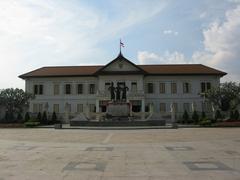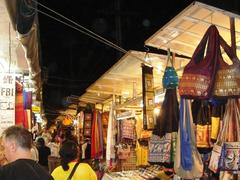Visiting Wat Umong Suan Phutthatham: History, Tips, and More
Date: 18/07/2024
Introduction
Nestled in the serene forested outskirts of Chiang Mai, Wat Umong Suan Phutthatham, often referred to as Wat Umong, represents an enduring testament to Lanna-style Buddhism in Thailand. Established in the late 13th century by King Mangrai, the visionary founder of Chiang Mai, Wat Umong’s tranquil environment offers visitors a unique blend of historical significance, architectural marvels, and serene natural beauty. The temple’s most distinctive feature, a network of ancient tunnels built into a man-made mound, was designed to provide a peaceful space for meditation, underscoring the temple’s significance as a center for spiritual growth and Buddhist scholarship. Today, Wat Umong continues to attract monks and visitors from around the world, offering a harmonious blend of historical significance, spiritual resonance, and natural beauty. This guide aims to provide comprehensive insights into Wat Umong’s history, key attractions, visitor information, and travel tips, making it an essential read for anyone planning to explore Chiang Mai’s historical sites. For more travel tips and guides, consider downloading the Audiala mobile app (Audiala) and follow us on social media for updates.
Table of Contents
- Introduction
- History and Significance
- Visitor Information
- Unique Features
- FAQ Section
- Conclusion
- References
History and Significance
Founding and Royal Patronage
Wat Umong’s origins can be traced back to the late 13th century, a period marked by the flourishing of Buddhism in the Lanna Kingdom. King Mangrai, the visionary founder of Chiang Mai and unifier of the Lanna Kingdom, established the temple in 1297. Recognizing the need for a tranquil space conducive to meditation, King Mangrai chose a site nestled within a lush forest, a stark contrast to the bustling city center.
The temple’s name, ‘Wat Umong,’ translates to ‘Tunnel Temple,’ a direct reference to its most distinctive feature—a network of ancient tunnels and chambers built into a man-made mound. These tunnels, commissioned by King Mangrai, were intended to provide a secluded and peaceful environment for monks to practice meditation undisturbed.
A Sanctuary for Meditation and Scholarship
Wat Umong quickly gained renown as a center for meditation and Buddhist scholarship. King Mangrai invited a revered monk named Thera Chan to reside at the temple. Thera Chan, known for his deep understanding of the scriptures and his commitment to meditation, attracted a following of monks seeking to deepen their practice.
The temple’s serene environment, coupled with the guidance of learned monks like Thera Chan, fostered a conducive atmosphere for spiritual growth. The tunnels, in particular, became integral to the meditation practices at Wat Umong. Monks would retreat into these dimly lit chambers, finding solace and focus amidst the quietude.
Evolution and Expansion Over Centuries
Over the centuries, Wat Umong witnessed periods of both prosperity and decline. During the Burmese occupation of Lanna in the 16th century, the temple fell into disrepair and was largely abandoned. However, its significance as a sacred site endured.
In the 1940s, a resurgence of interest in meditation practices led to the rediscovery and restoration of Wat Umong. The renowned meditation master, Ajahn Man Bhuridatta, played a pivotal role in reviving the temple as a center for meditation. Under his guidance, Wat Umong once again became a sanctuary for monks and laypeople seeking to deepen their understanding of Buddhist teachings and engage in intensive meditation retreats.
Architectural Significance and Cultural Heritage
Wat Umong’s architectural layout reflects a blend of traditional Lanna and Thai Buddhist styles. The temple grounds encompass a chedi (stupa), a viharn (prayer hall), several kuti (monk’s living quarters), and the iconic tunnel complex.
-
The Chedi: The large, bell-shaped chedi, believed to enshrine relics of the Buddha, stands as a prominent landmark within the temple complex. Its Lanna-style design, characterized by intricate stucco work and a multi-tiered roof, showcases the artistic heritage of northern Thailand.
-
The Viharn: The main prayer hall, or viharn, houses a revered Buddha image and serves as a central gathering place for religious ceremonies and teachings. The viharn’s interior is adorned with colorful murals depicting scenes from the life of the Buddha and stories from Buddhist scriptures.
-
The Tunnels: The ancient tunnels, carved into the man-made mound, remain the most distinctive feature of Wat Umong. These tunnels, with their low ceilings and dimly lit passages, evoke a sense of mystery and tranquility. The walls of the tunnels are adorned with ancient Buddhist murals, some dating back centuries, offering a glimpse into the evolution of Buddhist art and iconography.
Visitor Information
Ticket Prices
Admission to Wat Umong is free, although donations are welcome to support the maintenance and activities of the temple.
Opening Hours
Wat Umong is open daily from 6:00 AM to 8:00 PM. It is advisable to visit early in the morning or late in the afternoon to avoid the heat and enjoy a more serene experience.
Travel Tips
- Dress Code: Visitors should dress modestly, covering shoulders and knees, as a sign of respect.
- Footwear: Comfortable walking shoes are recommended due to the uneven terrain.
- Photography: Photography is allowed, but be mindful and respectful of the monks and other visitors.
Nearby Attractions
- Doi Suthep: A famous mountain temple offering stunning views of Chiang Mai.
- Chiang Mai Zoo: A family-friendly attraction located nearby.
- Old City: Explore the historic center of Chiang Mai with its ancient temples and vibrant markets.
Accessibility
Wat Umong is accessible by car, tuk-tuk, or bicycle. The temple grounds have some uneven paths and steps, so it may be challenging for visitors with mobility issues.
Unique Features
Special Events
Wat Umong hosts various Buddhist ceremonies and meditation retreats throughout the year. Visitors can check the temple’s schedule for upcoming events.
Guided Tours
Guided tours are available for those interested in a more in-depth understanding of the temple’s history and significance. These tours often include visits to the tunnels, viharn, and chedi.
Photographic Spots
The lush forest setting, ancient tunnels, and intricately designed chedi provide numerous photographic opportunities. Early morning and late afternoon offer the best lighting for photography.
FAQ Section
Q: What are the visiting hours for Wat Umong?
A: Wat Umong is open daily from 6:00 AM to 8:00 PM.
Q: Is there an entrance fee for Wat Umong?
A: No, admission is free, but donations are appreciated.
Q: Can I take photographs inside Wat Umong?
A: Yes, but please be respectful of the monks and other visitors.
Conclusion
Today, Wat Umong stands as a harmonious blend of historical significance, spiritual resonance, and natural beauty. The temple continues to serve as a center for meditation, attracting monks and visitors from around the world seeking respite from the outside world and a deeper connection with Buddhist teachings. The serene forest setting, punctuated by the chirping of birds and the rustling of leaves, enhances the sense of tranquility that pervades the temple grounds. Wat Umong offers a unique opportunity to step back from the frenetic pace of modern life and immerse oneself in the peaceful embrace of Buddhist tradition and practice.
For more travel tips and guides, download the Audiala mobile app (Audiala) and follow us on social media for updates and more inspiring travel content.
References
- Exploring Wat Umong Suan Phutthatham - History, Visiting Hours, and Tickets, 2024, Author source url
- Visiting Wat Umong - A Guide to Chiang Mai’s Tunnel Temple, Tickets, and Hours, 2024, Author source url
- Visitor Tips for Wat Umong Suan Phutthatham - Tickets, Hours, and More, 2024, Author source url

